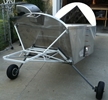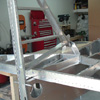


random user submitted photo
Battery Supplied Spark
6 posts
• Page 1 of 1
Battery Supplied Spark
Hello Everybody,
As I have been learning about the Sonex/Aerovee electrical system, I want to be sure I am understanding something correctly.
Since our alternator's do not produce enough energy to charge a battery until 2500 rpm's, I assume that the energy for a spark is coming from the battery. I am located at KILM which is busy enough and large enough that one can be taxiing and holding short 20 - 30 minutes on a busy day. If this were to happen, am I correct in stating that the engine will quit if the battery is run down during this time?
Aldo
As I have been learning about the Sonex/Aerovee electrical system, I want to be sure I am understanding something correctly.
Since our alternator's do not produce enough energy to charge a battery until 2500 rpm's, I assume that the energy for a spark is coming from the battery. I am located at KILM which is busy enough and large enough that one can be taxiing and holding short 20 - 30 minutes on a busy day. If this were to happen, am I correct in stating that the engine will quit if the battery is run down during this time?
Aldo
Aldo / Sonex #0954
TriGear/ Aerovee
Southport, NC
TriGear/ Aerovee
Southport, NC
- Aldo
- Posts: 31
- Joined: Mon Aug 25, 2014 2:25 pm
Re: Battery Supplied Spark
The Aerovee engine uses two ignition systems...an electronic system powered by the battery and a set of magnetos powered by strong magnets. It is true that if the battery runs flat the electronic system will not fire...however this isn't likely to happen in 30 minutes. Even if the electronic system is not working the engine runs great on just the magnetos.
Every time you get ready to fly you do a "mag check" to be sure that the engine will run on either of the system independently of the other.
Every time you get ready to fly you do a "mag check" to be sure that the engine will run on either of the system independently of the other.
- radfordc
- Posts: 573
- Joined: Fri Jun 03, 2011 9:39 am
Re: Battery Supplied Spark
I just turn off the electronic ignition and run on the mags when I have a long taxi or have to hold for a while. The engine runs fine on the mags once started
Keith
#554
Keith
#554
- kmacht
- Posts: 772
- Joined: Tue Jun 21, 2011 11:30 am
Re: Battery Supplied Spark
Aldo,
First, there's a difference between producing electricity and charging a battery. The alternator on your AeroVee will start producing useable power at about 1300 to 1500 rpm. It will need more RPM to create enough voltage to charge the battery, but it's producing enough power to run the electronics well before that. (Check your voltage output at idle and various other power settings. You'll see that it's at least 12 volts most of the time.)
Second, the magnetron (primary) ignition is self-contained and doesn't require a battery of any kind in order to produce a spark. So even if the battery were completely dead, the magnetrons would keep the engine running.
Any power being produced by the battery and alternator will be sufficient to keep everything working, even during extended ground operations. It will take a bit of time at cruise RPM to bring the battery charge level up to full charge.
A "battery maintainer" plugged in while the airplane is in the hangar is never a bad idea.
First, there's a difference between producing electricity and charging a battery. The alternator on your AeroVee will start producing useable power at about 1300 to 1500 rpm. It will need more RPM to create enough voltage to charge the battery, but it's producing enough power to run the electronics well before that. (Check your voltage output at idle and various other power settings. You'll see that it's at least 12 volts most of the time.)
Second, the magnetron (primary) ignition is self-contained and doesn't require a battery of any kind in order to produce a spark. So even if the battery were completely dead, the magnetrons would keep the engine running.
Any power being produced by the battery and alternator will be sufficient to keep everything working, even during extended ground operations. It will take a bit of time at cruise RPM to bring the battery charge level up to full charge.
A "battery maintainer" plugged in while the airplane is in the hangar is never a bad idea.
Joe Norris
Sonex N208GD (S/N 450)
Sonerai II N13NN (S/N 1206)
Fortes Fortuna Adiuvat
Sonex N208GD (S/N 450)
Sonerai II N13NN (S/N 1206)
Fortes Fortuna Adiuvat
-

Sonerai13 - Posts: 415
- Joined: Tue Nov 05, 2013 5:36 pm
- Location: Oshkosh, WI
Re: Battery Supplied Spark
Sonerai13 wrote:Second, the magnetron (primary) ignition is self-contained and doesn't require a battery of any kind in order to produce a spark. So even if the battery were completely dead, the magnetrons would keep the engine running.
Just a small point of clarification. The magetron doesn't require any electrical power source to create spark but it also won't create a spark until the prop is turning a few hundred RPM. I recently had the trigger magnet on the secondary ignition decide to depart the airplane while flying. The mags kept the engine running without me even knowing there was a problem. I only figured out it was missing after I went to start the plane the next time and the magnetron wouldn't produce enough spark at the speed the starter turns in order to fire the plugs.
Keith
#554
- kmacht
- Posts: 772
- Joined: Tue Jun 21, 2011 11:30 am
Re: Battery Supplied Spark
Aldo wrote:I am located at KILM which is busy enough and large enough that one can be taxiing and holding short 20 - 30 minutes on a busy day.
Aldo
With all due respect I think that a long taxi and a hold of 30 minutes in an Aerovee Sonex on a 90ºF day in Southport, N.C. would have you more concerned with CHTs than battery voltage ...
JMHO,
Dale
N319WF
-

daleandee - Posts: 877
- Joined: Fri Feb 01, 2013 6:14 pm
6 posts
• Page 1 of 1
Who is online
Users browsing this forum: No registered users and 11 guests







